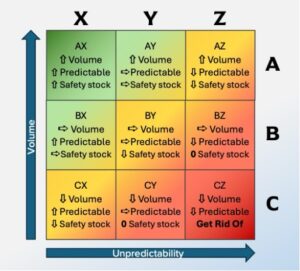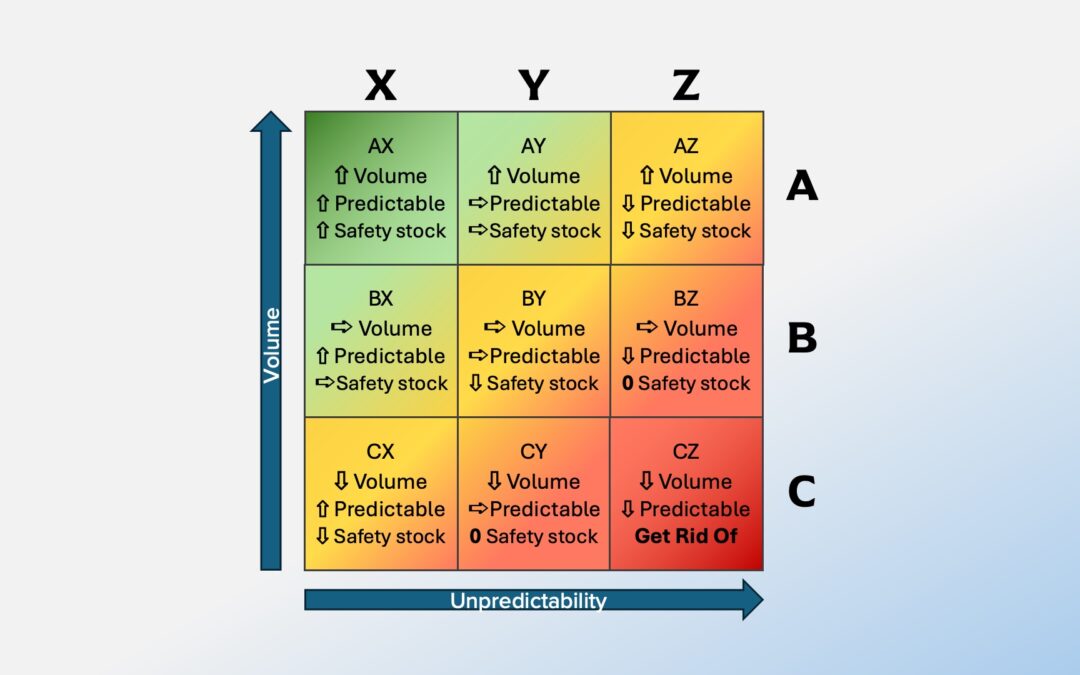Back in January, we talked about tail spend and ways to reduce your spend with the bottom 20% of suppliers. But what if you don’t really know which tail spend items/suppliers to keep and which to get rid of? What else should we think about when classifying our inventory materials? Today’s article explores the ABC XYZ system of inventory management and has some answers to those questions.
ABC Materials
The first dimension of categorizing inventory materials is to classify them by volume and/or spend. The typical classification method is to assign letters A, B and C:
- A materials – These are the highest volume, highest spend, and most strategic items. These are the key materials and components that run your business and lead to your highest sales. In manufacturing, these might be standard steel bar stock sizes and high volume fasteners. In a utility, these might be the most common size of cable and distribution transformers.
- B materials – These are medium volume and medium spend parts, likely provided by suppliers with lots of competition who are less strategic. In manufacturing, this is the moderate volume components, like less standard fasteners or components from a lower volume product line. In a utility, this might be commercial-size transformers or less common-sized wood poles.
- C materials – This is the “rest of the mess” or the tail spend. These are low volume materials, sometimes items that have been sitting in inventory for years.
The simplest way to run this classification is to simply run a report for your annual spend by part number, then sort by highest to lowest volumes. You might also run the same report of cost per piece times volumes to isolate the slightly lower volume parts that carry a higher spend. Make some decisions about where your A, B, and C cutoffs are, but A is probably 5-10% of your part numbers and 30-40% of your volume, B is the next 10-15% of your part numbers and is another 40-50% of your volume, and C is what remains, about 80% of your part numbers and 20% of your volume.
XYZ Materials
Now that you’ve classified your materials by volume, let’s talk about risk. Risk means many things, but in this case we’re talking about volume risk or volatility. Material volatility means how much volumes fluctuate and how predictable those fluctuations are. Seasonal volatility that is predictable (such as for a holiday rush or due to warm or cold weather) is fairly predictable, even if the usage swings wildly between the high and low volume seasons. When classifying parts by volatility, we use XYZ labeling:
- X materials – These are low risk, highly predictable parts. They are as predictable as the sun and have steady cycles (or no cycle at all). In manufacturing, this is probably your bar stock or your most popular color of plastic pellets for injection molding. In an energy utility, this might be your valve gaskets or filters.
- Y materials – These are the medium risk, somewhat predictable parts. There might be events or unpredictable seasons that make these a bit harder to predict than the X materials. In manufacturing, this might be the “odd” materials such as specialty metals or even higher wear machinery maintenance parts. In a utility, it might be bucket trucks or gas line odorizers (side note: gas line odorizers are pretty neat! They put the odor in natural gas, which is naturally odorless, so people can detect when there are leaks. When they go bad, they often will actually over-odorize a line, so suddenly a utility gets a bunch of phone calls for gas leaks when there aren’t any).
- Z materials – This last classification of materials are all the unpredictable, volatile parts. These are the parts that someone keeps a spare in the back “just in case” or tend to get used all at once and then not touched for weeks or months. Anything “trendy” falls in this category, or things that move based on world events. For manufacturing, this would be products where the demand from customers is unpredictable or niche, such as a low volume product where customers also order many at once. For utilities, storm response materials are the classic case where the materials needed vary wildly based on the size and type of storm.
To classify materials as X, Y, and Z, graph their usage per day/week/month (base on parts issued out of the warehouse, not parts ordered), whatever makes sense for your business. Decide on a cutoff for volatility, potentially based on variance as a percentage of total usage. Remember you can always change your cutoffs later as things change or as you learn certain parts should belong in different categories.
Putting It Together
Now that you have your inventory classified by ABC and XYZ, what do you do about it? While choosing favorite inventory as a supply chain practitioner is like choosing a favorite child, AX inventory is clearly the favorite. It’s predictable, high volume, and should have lots of negotiation leverage. Here’s more detail on what to do with each classification:

- AX – These are the best and easiest to manage. Make sure you leverage both the predictability and volume with suppliers, and work with the design/engineering team to standardize designs to use these parts wherever possible. Consider having secondary suppliers for part of these volumes such as awarding 20% of the business to a secondary supplier to ensure supply.
- AY and BX – These are either high volume and moderate predictability or high predictability and medium volume. There is still probably good leverage with these suppliers, so use that leverage well. Keep a medium amount of safety stock on these parts.
- AZ, BY, and CX – These are the “middle of the road” parts for the purposes of inventory management. Try not to get too bogged down in managing these as they are higher risk with lower reward. Work to keep lead times as short as possible, even considering paying a higher price for a shorter lead time (within reason) to keep safety stock low.
- BZ and CY – These are the headache parts. Consider making these Vendor-Managed Inventory (VMI), although for a big VMI program you’ll probably need to give the supplier some of the parts in other areas too. Don’t keep safety stock for these parts, it will just bog you down.
- CZ – Ah, the parts way down in the bottom right. These parts are unpredictable and low volume. These are things like critical spares for your machinery or the highly specialized part for that one product you only ever make when someone calls up and asks for it. Find ways to get rid of these parts. Some options might be to join a sharing program where a third party stocks these parts and manages them, or even work with other companies (yes, even competitors) who need that same part to share the burden of stocking them. You might even work to figure out which other industry uses these parts more frequently and see if you can either purchase CZ parts from them or share their distribution network.
Today we’ve classified our inventory parts, organized them, and started figuring out what to do with them. Go tackle your own parts list and see if you can start putting some items into buckets to reduce your inventory. Inventory is cash flow and cash is king, so reducing inventory will both free up space in the warehouse and free up capital. If you would like to talk about your inventory and cash flow, let’s chat.




